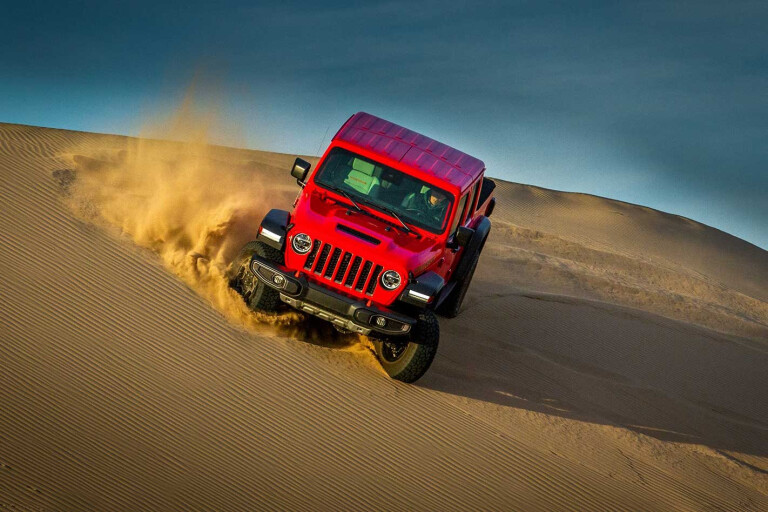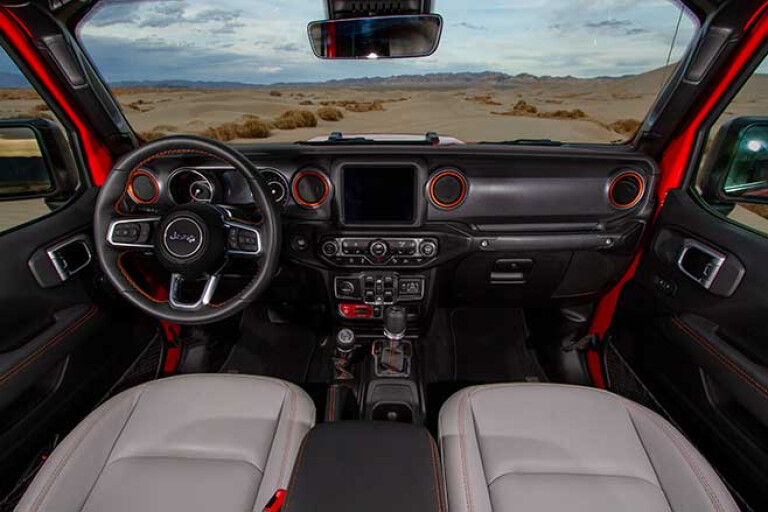
Australian deliveries of the Jeep JT Gladiator are finally getting out to customers this month in both the Gladiator Overland and Gladiator Rubicon ‘International’ specification.
This is a big moment for a 4x4 we're calling one of the most significant launches of recent times.
A variant we won’t be getting is Jeep’s latest JT model the Gladiator Mojave, which has been built as desert rig more so than an off-road crawler like the Rubicon.
To see what makes the Mojave special, our man in the USA, Chris Collard, took one out to the Nevada dunes for a blast.
The Jeep Wrangler has set the bar in the off-road world for decades, and its reputation as a capable trail rig is undisputed. But when the Gladiator JT debuted in 2019, the brand’s first pickup in nearly 30 years, it rattled the industry, receiving praise and persecution.

The cynics sited its length, wheelbase, and reduced break over angle simply didn’t fit the bill for serious four-wheeling. But for truck guys like me, a Jeep pickup was long overdue. Comfortable seating for four adults, live axles, a nimble suspension, vetted drivetrain, and room for heaps of gear…what’s not to love.
While the Rubicon model is crafted for the rock-crawling crowd and the Overland is ideal for adventure seekers, the seven-slot powers-that-be realised the JT might be the perfect platform for dust-loving dirt aficionados that like to go fast in the desert. Enter the 'Desert Rated' Gladiator Mojave.
Having spent thousands of hours in various Jeeps on a multitude of continents and terrains, I was curious as to what differentiated the Mojave from the masses. And what is “Desert Rated” all about?
To settle the discussion, fellow journalist Ned Bacon and I borrowed a Mojave for a multi-day, 500-mile (800km) evaluation through the deserts of Northern Nevada.

Between us, we’ve raced the Baja and Mexican 1000, tested shocks and suspension systems, crossed the world’s seven continents by four-wheel drive, and have a pretty good feel for what works and what doesn’t. But first, let’s examine the platform.
When developing the Gladiator, Jeep went beyond simply stretching a four-door JL. Working with Ram Trucks, they beefed up the frame, axles, and suspension to improve handling, and increased payload and towing capacities.
The powertrain remains the venerable 3.6-litre Pentastar V6, which produces a respectable 213kW and 353Nm. Transmission options are a 6-speed manual (base) and 8-speed slushbox backed by the CommandTrac NV241 transfer case.
Either combination provides a good balance between performance, economy, and off-road prowess.
The interior features all of the amenities we expect from a new Jeep; an ergonomically comfortable cockpit, 80-plus safety systems, Gen IV U-connect touchscreen nav/audio panel, Apple CarPlay, Siri, and plenty of connectivity options and power points.
Overall mass was reduced via the use of aluminium doors, fenders, tailgate, and other components, and as is the case with all descendants of the Willys, you can kick the windshield down for a grand view of the world.
Pack all this into a 4-door pickup and it’s everything a truck guy could ask for. Well, almost everything.
DESERT RATED
It’s been a long time since Jeep dipped its grill in the go-fast desert scene, so it was a bit of a surprise when they announced 'Desert Rated' badging.
The designation indicates a focus on five key attributes; maneuverability, traction, ground clearance, ride control and stability, and desert prowess—a few of which are lofty goals for a live axle rig (think, unsprung weight).
The magic of the Mojave is found in its suspension, which is supported by electronics enhancements.

Fox Racing's 2.5-inch internal bypass shocks top the list. Sporting 22mm heat-treated chrome-plated shafts, aluminium bodies and remote reservoirs, they are specifically tuned for controlled damping in rough high-speed conditions.
The progressive front coil springs are out of the Rubicon’s playbook, but complemented by Fox hydraulic (nitrogen) bump stops—an industry first for an OE offering.
Rear spring rates are slightly reduced, a balance that retains load capacities while providing a lighter feel at speed over uneven terrain.
Interior enhancements are subtle. Climbing behind the wheel, you first notice the seats have a sportscar feel. Lumbar support, headrests, and more pronounced bolsters and wings tuck your body into place like a cocoon.
The leather-wrapped steering wheel rim features raised thumb rests just above the lateral spokes, and Mojave Orange accents run throughout. Toggling through the apps screen we find the forward-facing off-road camera, which provides a wing-to-wing view of the bumper and immediate foreground.

Moving on to electronic wizardry, this desert dueler includes a new variant of the brand’s Off-Road Plus mode. Pressing this delightful button modifies transmission shift points, throttle response, and de-tunes the Traction Control system.
You can also permanently disengage electronic stability control (ESC), giving the driver full command (and responsibility) of the vehicle without an electronic babysitter overriding his/her judgement. If you’ve had ESC cut power while carving turns on big dunes, you will agree this is a huge safety enhancement.
Off-Road Plus will also allow rear locker engagement in high range. This was not available on our test rig, but we are told it will be standard issue in late 2020.
ON THE TRACK
Testing began in a remote dune field south of Tonopah, Nevada, which provided ample opportunity to evaluate the Mojave in its native environment.
We immediately noticed that Off-Road Plus rendered the throttle more responsive and raised shift points dramatically. In drive, they were spot-on when mashing the happy pedal to the floor. But when taking it easy, the mill still spooled up to about 5,000rpm before finding the next cog.
I’m a manual transmission guy, so sliding the shifter to the left and toggling through the gears was natural—it also allowed me to manage RPM and power to the ground more precisely. With ESC furloughed, carving big turns and high-speed sidehill drifts was a thing of beauty.

Day 2 found us running endless miles of two-tracks through the ghost towns of Nevada’s mining districts. The Fox bypass shocks earned their keep in the realm of yaw damping after hard turns (think emergency lane change).
Return-to-neutral cycling was excellent, especially for a live-axle, off-the-shelf vehicle. We also experienced less 'head bobbing' as the vehicle rolled left and right; another result of a properly balanced shock/spring combination.
Corrugated roads (low amplitude high-velocity conditions) are king when it comes to assessing harshness and thermal buildup. If a shock doesn’t properly control how fluid moves past the piston and valving, the ride will be harsh and associated friction will generate heat.
This can lead to cavitation, which will eventually cause the shock to 'fade' in performance.
After several hours of high-speed twin-tracks, the shocks were still cool to the touch—another benefit of good valving and remote reservoirs. I don’t think there is a live-axle vehicle made that can match a well-tuned IFS on washboard, but the Mojave comes pretty close.
General damping—the ability of the shock to absorb impact firmly and rebound under control—was very impressive. In G-out situations (full compression), we could feel the hydraulic bump stops engage, easing the last two inches of travel without feeling we hit a hard bottom.
The combination of these attributes lent the Mojave to be very predictable, instil driver confidence, and blast through most terrain without flinching.
I do have one gripe, maybe two. With the driver’s side visor rolled out to shield against the afternoon sun, it rattled like a snare drum against the window. A simple clip could eliminate this. The second is more of an industry grievance.
I’ve yet to get used to drive-by-wire accelerators. It doesn’t matter what vehicle I’ve driven; they all seem to suffer from jetlag syndrome - the time between when my brain tells my foot to go fast, and when the engine responds to the data. I suppose I need to think faster.

Lastly, and more of a wish list item is the need for a HEMI. I’m a fan of the Pentastar V6, but when you want to go fast…you want to go fast faster!
The Mojave’s 213kW of power is ample for most conditions, but there is nothing like the seat-of-your-pants feel (and acoustic bliss) of 395 ponies under the hood. Come on guys, give us a 5.7!
When the dust settled, we had three days and more than 800km of mixed terrain under the tyres.
Considering this is an off-the-shelf offering, Ned and I were surprisingly impressed, and agreed this new Gladiator is well-deserving of its Desert Rated badge.
The Mojave gobbled up rough desert tracks like a hot fudge sundae and dove back into the menu for more. It is just plain fun to drive.

COMMENTS